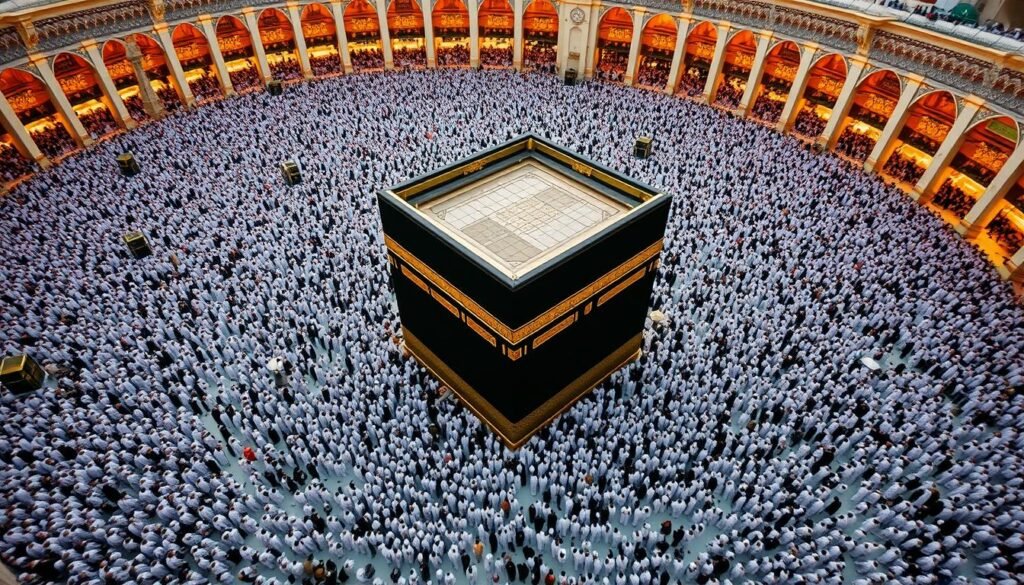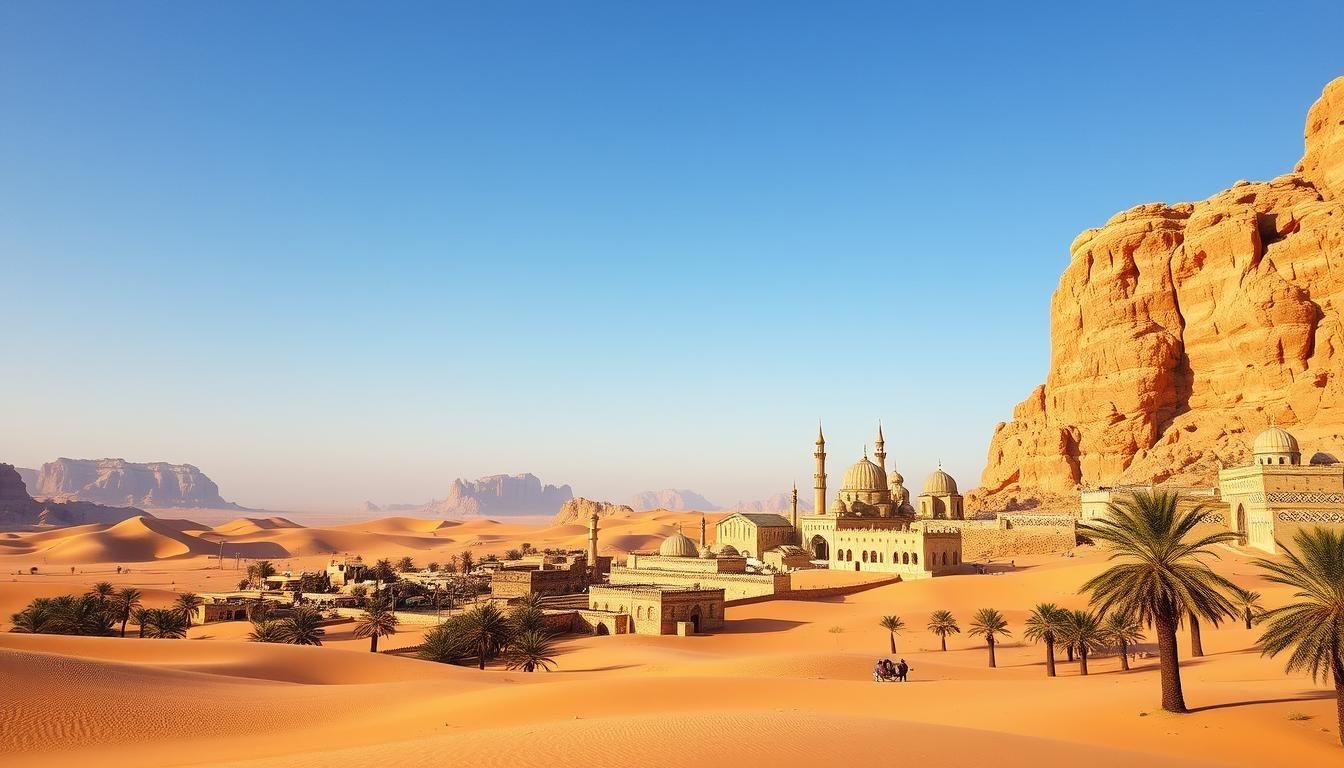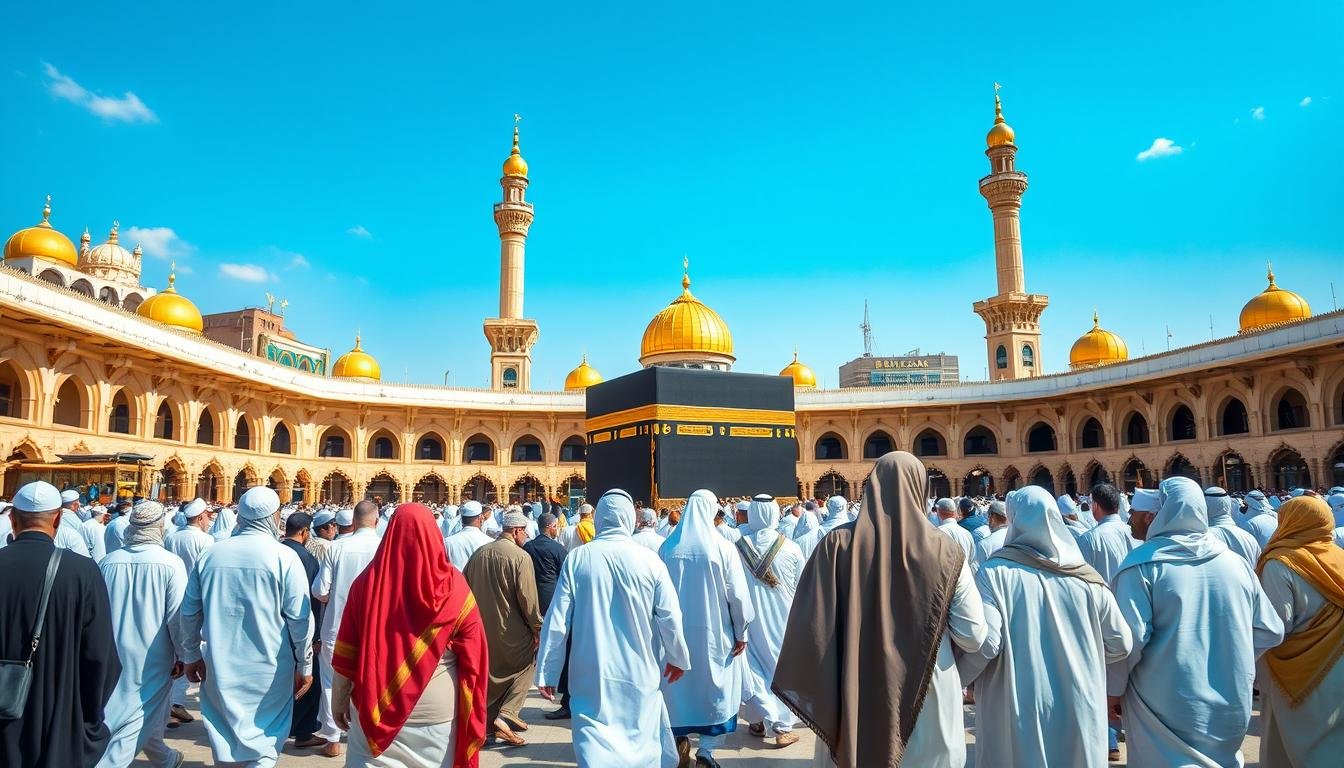To truly understand Islam’s spiritual core, we must explore the Kaaba. This cube-shaped structure is at the heart of Mecca. It has been a sacred Islamic holy site for centuries, drawing believers from around the world.
But what makes the Kaaba so important in Islam? Let’s journey together to discover its history and role as the House of Allah.
Why is the Kaaba the most sacred site in Islam? It attracts millions of Mecca pilgrimage devotees each year. In this guide, we’ll uncover the Kaaba’s origins, its symbolic meaning, and the sacred rituals tied to it.
Understanding the Sacred House: An Introduction to the Kaaba
The Kaaba is in the heart of Mecca, a city holy to Islam. It is the center of prayer for Muslims everywhere. Its history and design have touched the hearts of believers for ages.
Defining the Kaaba’s Role in Islam
The Kaaba is the holiest place in Islam. It is seen as God’s house. Muslims pray five times a day facing the Kaaba, a practice that unites them spiritually.
Geographic Location and Physical Description
The Kaaba is in the Masjid al-Haram mosque in Mecca, Saudi Arabia. It’s a cube, 45 feet high and 35 feet wide. A black cloth with gold calligraphy, the Kiswah, covers it, replaced every year during the Hajj.
Basic Elements and Structure
The Kaaba’s inside is simple, with a few key parts. The Black Stone is in the eastern corner. There’s a wooden staircase and a gold door frame. The walls are made of local stone, covered in marble.
Pre-Islamic Origins and Evolution of the Kaaba
The Kaaba is a sacred place at the heart of Islam. It has a rich history that started before Prophet Muhammad. We explore the ancient Arabian practices that shaped this iconic structure over time.
Ancient Arabian Religious Practices
In the pre-Islamic era, the Arabian peninsula was full of different beliefs. The Kaaba, known as the “House of God,” was very important. People from local tribes would gather there, perform rituals, and worship their gods and goddesses.
Prophet Ibrahim’s Connection
Islamic tradition says Prophet Ibrahim (Abraham) and his son, Ismail (Ishmael), built the Kaaba. This shows the Kaaba’s importance as a sacred site before Islam. It was rebuilt and restored many times, showing the region’s rich history and Ibrahim’s spiritual legacy.
Transition to Islamic Significance
When Islam emerged in the 7th century, the Kaaba’s role changed. Prophet Muhammad, a descendant of Ibrahim, removed the pre-Islamic idols. He made the Kaaba the qibla, the direction Muslims face during prayer. This made the Kaaba the most sacred site in Islam, showing its evolution into a key Islamic institution.
The Black Stone: Divine Symbol and Sacred Relic
The Black Stone is a key Islamic relic with deep meaning. It’s in the Kaaba’s eastern corner, the heart of Islam. For centuries, it has drawn pilgrims and worshippers.
It’s believed to come from heaven, symbolizing God’s promise to humans. Its dark color and heavenly origin make it powerful. Muslims touch or kiss it during Hajj and Umrah to show devotion and seek blessings.
The Black Stone’s history is full of mystery. Some say it was once white, darkened by human sins. Others think it’s a meteorite. But its true origins don’t matter; it’s a symbol of great spiritual value.
The rituals around the Black Stone are key to Hajj and Umrah. Pilgrims try to touch or kiss it to feel closer to God and clean their sins. The stone’s spot in the Kaaba also guides Muslims in prayer, showing its importance.
| Ritual | Significance |
|---|---|
| Touching or Kissing the Black Stone | Affirms devotion and seeks blessings from the Almighty |
| Orientation towards the Black Stone during Prayers | Establishes the qibla, the direction of prayer |
| Seeking Forgiveness and Purification | Cleanses the pilgrim of sins and brings them closer to God |
The Black Stone’s lasting importance in Islam shows its deep role. It connects Muslims to the divine, inspiring devotion and spiritual connection worldwide.
Architectural Development Through Islamic History
The Kaaba, at the heart of Islam, has seen a lot of changes over time. This sacred site has been updated many times. Each update aimed to keep its spiritual value and physical strength.
Major Renovations and Reconstructions
For centuries, the Kaaba has gone through big changes. These changes were to keep it strong and meet the needs of Muslims. From the early days of Islam to now, the Kaaba has been rebuilt and restored many times. This shows how much Muslims value this holy place.
| Period | Major Renovation or Reconstruction |
|---|---|
| Pre-Islamic Era | The Kaaba was an important pagan shrine, with various deities and idols housed within its walls. |
| 610 CE | Prophet Muhammad (peace be upon him) cleansed the Kaaba of its pagan influences and rededicated it as the House of God. |
| 631 CE | The Kaaba was rebuilt and expanded under the rule of the second caliph, Umar ibn al-Khattab. |
| 683 CE | The Kaaba was damaged during a siege and was subsequently rebuilt under the Umayyad caliph, Abd al-Malik. |
| 1039 CE | The Kaaba was extensively renovated and restored under the Fatimid caliph, al-Mustansir. |
Modern Structural Enhancements
Recently, the Kaaba has seen updates to keep it safe and accessible. These changes have made the Kaaba better for more people. They have also kept its spiritual importance.
- Renovation and expansion of the surrounding Grand Mosque (Masjid al-Haram) to accommodate more worshippers
- Installation of advanced climate control and lighting systems to protect the Kaaba from environmental factors
- Upgrades to the Kaaba’s marble cladding and the addition of reinforced concrete foundations to enhance its structural integrity
- Improvements to the Mataf (the circular walkway around the Kaaba) to facilitate the ritual of Tawaf (circumambulation)
These updates show the Muslim community’s dedication to the Kaaba. They want to keep it as a symbol of their faith and a part of Islamic history.
The Kaaba as the Universal Direction of Prayer
The Kaaba is at the heart of the Masjid al-Haram in Mecca. It holds deep spiritual meaning for Muslims everywhere. It serves as the Qibla, the direction all Muslims face during prayer.
Praying towards the Kaaba, known as Salat, brings Muslims together. It doesn’t matter where they are in the world. They all face the Kaaba, feeling a strong bond and shared goal.
The Qibla direction points to the Kaaba, symbolizing Muslims’ spiritual connection. It reminds them of their faith and each other. This practice helps Muslims feel a deep sense of unity and divine guidance.
The Kaaba’s role as the Qibla also has deep symbolic meaning. It shows the unity and universality of Islamic teachings. This practice proves that Islam is not limited by place or culture. It connects believers in a spiritual journey beyond the physical world.
Rituals and Practices Associated with the Kaaba
The Kaaba is at the heart of the Mecca pilgrimage. It’s the center of many sacred rituals in Islam. Two key ones are the tawaf, or circling the Kaaba, and saying specific prayers.
Tawaf: The Sacred Circumambulation
Millions of pilgrims circle the Kaaba during Hajj and Umrah. They walk counterclockwise, showing unity and harmony. This act is a way to show respect and seek purification.
Specific Prayers and Supplications
Pilgrims also pray and make requests at the Kaaba. They recite the Quran, invoke God’s names, and offer personal prayers. The Kaaba is seen as a place where the spiritual and physical worlds meet.
| Ritual | Description |
|---|---|
| Tawaf | The act of circling the Kaaba in a counterclockwise direction, as a symbol of unity and reverence. |
| Specific Prayers and Supplications | The recitation of Quranic verses, the invocation of God’s names, and personal prayers and requests at the Kaaba. |

These rituals and practices are key to the Islamic faith. They help believers connect with the divine, show devotion, and unite the global Muslim community.
The Role of the Kaaba in Hajj and Umrah
The Kaaba is at the heart of the Mecca pilgrimage and is very important to Muslims everywhere. It is the center of the Hajj and Umrah pilgrimages. Millions of faithful people come to the Islamic holy sites every year.
The Hajj is a key part of Islam and is a must for those who can afford it. During the Hajj, the Kaaba is the main focus. Pilgrims do the Tawaf, a special walk around the Kaaba, as part of their rituals.
Umrah is a voluntary pilgrimage that can be done anytime. It’s not as big as the Hajj but still involves the Tawaf ritual. This allows devotees to feel closer to the divine and connect with the Muslim community.
The Kaaba’s role in Hajj and Umrah is huge. It’s the ultimate goal for millions of Muslims. They come to fulfill their duties, strengthen their faith, and connect with the divine.
| Hajj | Umrah |
|---|---|
| Mandatory religious duty for Muslims | Voluntary pilgrimage |
| Performed annually during the Islamic month of Dhu al-Hijjah | Can be performed at any time of the year |
| Includes the essential Tawaf ritual around the Kaaba | Includes the essential Tawaf ritual around the Kaaba |
| Draws millions of pilgrims to the Islamic holy sites | Allows devotees to experience the unity of the Muslim Ummah |
Spiritual Symbolism and Religious Significance
The Kaaba, known as the “House of Allah,” holds deep spiritual meaning and great religious importance in Islam. It’s not just a building; it symbolizes the unity and connection of Muslims worldwide, the Ummah.
Unity of the Muslim Ummah
The Kaaba is a central point for Muslims, bridging gaps between different places, cultures, and languages. Muslims from all over the world face the Kaaba during their prayers. This creates a strong sense of unity and spiritual connection among them.
Divine Connection and Spiritual Elevation
The Kaaba is seen as the closest spot to God on Earth. Muslims believe that walking around the Kaaba, or Tawaf, brings them closer to the divine. It’s a way to deepen their spiritual bond with the House of Allah.
The Kaaba’s spiritual and religious value goes beyond its physical form. It reminds Muslims of Islam’s universal teachings and the bond that ties them together as a global community.

Modern-Day Management and Preservation
The Kaaba is a sacred Islamic site that needs careful management and preservation. The Saudi Arabian government and Islamic organizations work hard to protect it. They focus on maintenance and security to keep the Kaaba safe.
Over the years, the Kaaba has gone through many changes. Recently, big investments have been made to update its structure. These updates use new technology while keeping its historical and religious value.
Keeping the Kaaba in good shape is a big job. Architects, engineers, and custodians work together. They make sure the Kaaba stays strong, beautiful, and sacred for future generations.
FAQ
What is the religious significance of the Kaaba?
The Kaaba is the most sacred site in Islam, known as the “House of Allah.” It is the direction Muslims face during their five daily prayers. It is also the focal point of the annual Hajj pilgrimage to Mecca, one of the five pillars of Islam.
Where is the Kaaba located?
The Kaaba is in the center of the Masjid al-Haram mosque in Mecca, Saudi Arabia. It is the holiest site in Islam. It is the direction Muslims face during their daily prayers, known as the Qibla.
What are the basic elements and structure of the Kaaba?
The Kaaba is a cubic structure made of granite and limestone. It is about 13.1 meters (43 feet) high, 11.03 meters (36.2 feet) wide, and 15.24 meters (50 feet) long. The Kaaba is draped in a black cloth embroidered with gold calligraphy, known as the Kiswah.
What is the history and origin of the Kaaba?
The Kaaba has a long and complex history, dating back to pre-Islamic times. According to Islamic tradition, the Kaaba was first built by Prophet Abraham (Ibrahim) and his son Ishmael (Ismail) as a house of monotheistic worship. Over the centuries, the Kaaba was a site of various pagan idols and rituals until the time of Prophet Muhammad, who cleansed it of these practices and re-established it as the central place of worship for Islam.
What is the significance of the Black Stone?
The Black Stone, located in the eastern corner of the Kaaba, is considered a sacred relic in Islam. It is believed to have been sent down from heaven and given to Prophet Abraham by the angel Gabriel. Muslims perform a ritual known as Istilam, where they try to kiss or touch the Black Stone during the Tawaf (circumambulation) of the Kaaba.
How has the Kaaba evolved architecturally over time?
The Kaaba has undergone several renovations and reconstructions throughout its history. Major events include the rebuilding of the Kaaba by Prophet Muhammad, the various expansions and restorations carried out by successive Islamic dynasties, and the modern-day efforts to preserve and protect the structure through structural enhancements and security measures.
How does the Kaaba serve as the universal direction of prayer for Muslims?
The Kaaba is the Qibla, the direction that Muslims face during their five daily prayers. This unifying practice serves as a symbol of the unity of the global Muslim community. It connects believers worldwide in their devotion and spiritual connection to the sacred site.
What are the rituals and practices associated with the Kaaba?
The Kaaba is the focal point of several important Islamic rituals and practices. These include the Tawaf (circumambulation), specific prayers and supplications, and the Ihram (sacred clothing) worn by pilgrims during the Hajj and Umrah pilgrimages.
What is the role of the Kaaba in the Hajj and Umrah pilgrimages?
The Kaaba is the central and most significant destination for Muslims undertaking the Hajj and Umrah pilgrimages. Pilgrims perform various rituals and activities around the Kaaba. This is part of their spiritual journey and connection to the sacred site.
What is the deeper spiritual symbolism and significance of the Kaaba?
The Kaaba represents the unity of the Muslim Ummah (community) and serves as a symbol of the divine connection and spiritual elevation sought by believers. It is seen as the “House of Allah,” a place of profound reverence and a focal point for the global Muslim community’s devotion and worship.
How is the Kaaba managed and preserved in modern times?
The Kaaba and the surrounding Masjid al-Haram mosque are under the custodianship of the Saudi government. Ongoing efforts are made to maintain, secure, and preserve the sacred site. This includes structural enhancements, security measures, and initiatives to protect the Kaaba for future generations of Muslim pilgrims.
Don’t forget to share your experience in the comments and follow us on social media at the bottom of the site.






